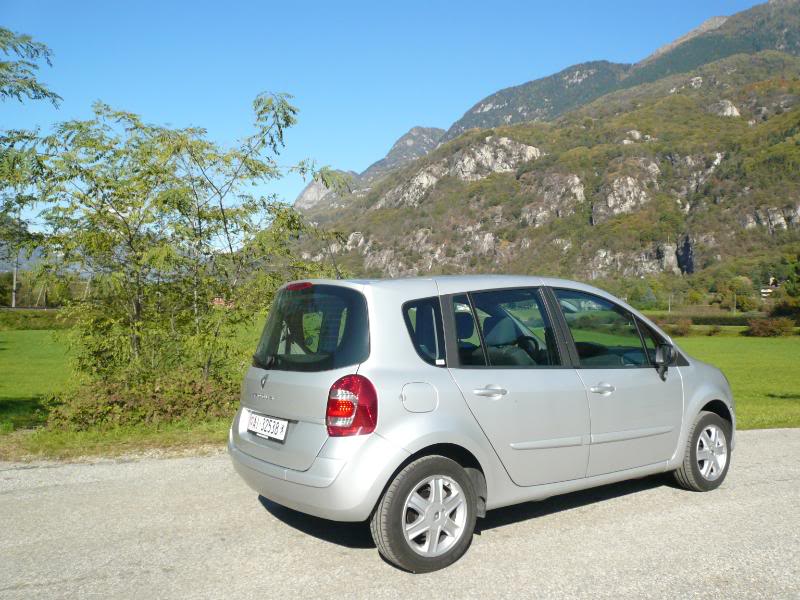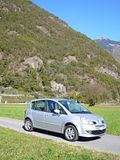

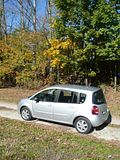
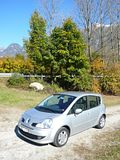
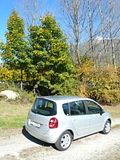
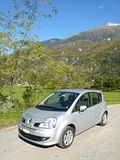
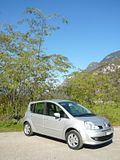
Having introduced the first MPV vehicle to Europe, with the Espace in 1984, just months behind the Chrysler Corporation’s first generation Voyager and Caravan minivans, Renault are largely credited with inventing and popularising the family-sized equivalent, the Scenic, which has been a huge success for the French company. They were not the first to offer a baby sized MPV, as the Meriva arrived in 2003, and Fiat’s Idea also hit the market before the 2004 launch of the Modus, but you can be sure that Renault were hoping for 3 wins out of 3. Although the little Modus was well received, it failed to sell in anything like the volumes expected. In an effort to try to expand the appeal of the model, a longer wheelbase car, the Grand Modus appeared a couple of years ago, offering a bit more space for people and luggage in what is still a pretty small car, and easily distinguishable from its smaller brother by the presence of a third side window, behind the rear doors. It is this version of the small French car that I have been testing, with a day out in the autumn sunshine on a trip from Zurich to Bellinzona and back.
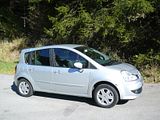



As with many cars, the facelift of the Modus and the introduction of the Grand Modus brought some detailed styling changes, many of which could be said to have been to introduce a level of fussiness into the original design. The Grand Modus has a chrome strip across the tailgate, and some extra silver detailing around the front lights and faux grilles, none of which constitute an improvement to my mind. The test car was in Dynamique trim level, which brings 15″ alloy wheels and front fog lights to the model, and for those selecting metallic paint, body coloured bumpers, and inside brings a leather covered steering wheel and gearlever knob. As well as the Mercury Silver paint, the test car featured some other options, including cruise control with speed limiter warning, and climate control. There are plenty of other options available on the list. More importantly, there are quite a few features that are not standard on the cheaper models in the range, the absence of which you may well regret, such as the lack of sliding rear seats.
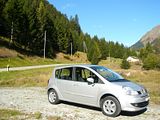
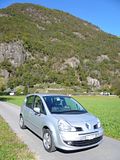
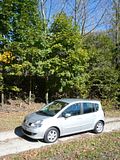
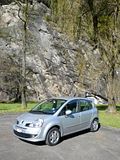
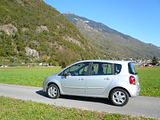
The bonnet on the Grand Modus is very small, and when you lift it, you can barely see much of the engine, let alone access it. I suspect that removing the large plastic cover would help matters, but accessibility would not appear to be a forte on this design. Large stickers under the bonnet confirmed what was on the rental car paperwork, namely that the test car was fitted with the 1.6 litre 16 valve VVT engine, which develops 111 bhp, and it was combined with a 4 speed automatic gearbox. It would seem that this particular combination is only available for the Grand Modus and only in Dynamique trim, but there are plenty of other permutations in the range. On the mountainous roads approaching the San Bernadino, this was not always a happy combination. The biggest problem seemed to be the way that the gearbox would try to decide when to change gear, sometimes going from second almost immediately to third and then fourth, and as the engine is not overly endowed with torque this meant that you could find yourself trying to accelerate out of a hairpin uphill bend and losing momentum pretty quickly, until it figured out that it did indeed need to change down again. Other times, it would hang on to the lower gear when your ears told you that it really needed the next one in the ‘box. There are “flappy paddles”, although they were far from flappy, high on the column, so you could sometimes put it out of its, and your, misery and do the deed for the gearbox. Although fourth gear seemed quite high, with just 3250 rpm showing at the Swiss autobahn limit of 120 km/h, the Grand Modus was quite noisy when cruising, which would become quite wearing after a while.
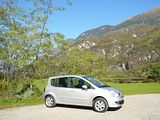
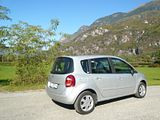
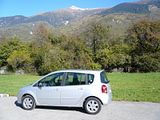
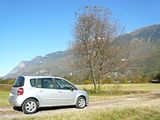

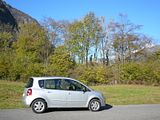
Acceleration, as you might expect, is not really of the tyre burning type, either, though if you put your foot down hard, it could propel itself into gaps in the traffic in the way that you need. Driving in town and on “easier” roads, few of these limitations were anything like as apparent, and you might even conclude that the automatic gearbox combined with a reasonably powerful engine in a small car was a good match, though you would never conclude the Grand Modus was fast, and loaded up with people and luggage, I suspect it could be downright slow. I was intrigued to calculate the final economy, as the first bar on the gauge took for ever before it extinguished, but soon after that the next and then the next went down. By lunchtime, the gauge showed just half full, which persuaded me that I was not going to make it back to Zurich without an intermediate refill. Of course, the return from Bellinzona appeared to use rather less fuel, so I would have been OK to have bought fuel only as I was returning the car. Stabbing at the calculator revealed an average of 38 mpg for my test day, over 552km, which is OK, but not startlingly good. The Grand Modus’ trip computer advised me that since it had been reset, it had done 8 litres/100km, which amounts to 35.4 mpg, so I clearly did better than some of the people who had driven the previous 13,000km in it!
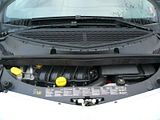
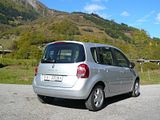
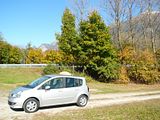
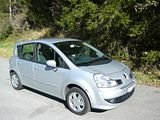
You don’t expect a tall car like this to be the ultimate driving machine, and while the Grand Modus certainly was not that, I was quite agreeably surprised. The steering is indeed light, but not so totally devoid of feel that you know it is not physically connected to the wheels at all. Handling was better than I expected, too, without undue levels of either understeer or roll. The brakes were certainly powerful, and required a modicum of restraint when pressing the footbrake, unless one wished to emulate a display, legendary on this forum when someone who shall remain nameless mistook the footbrake for the clutch of an automatic Modus and virtually stood the car on its nose (or so I am told by both passenger and driver!). There is a pull-up handbrake between the seats, but it is barely required when the automatic transmission is fitted as was the case with the test car. It was the ride that impressed me, seeming to smooth out many of the imperfections on the surface that you could see and indeed hear as the car traversed them.

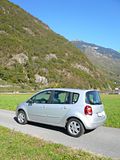
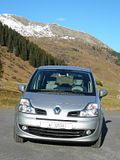
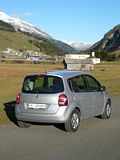
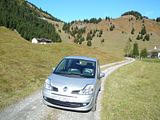
Unlike many cars on the market these days, visibility is excellent, and judging the extremities of the car proved easy. A previous renter clearly found it less so, judging by the significant scrape on the front bumper by the front wheel. That said, the door mirrors were mounted well back – too far back in the case of the passenger side mirror. I can see why this was done, as mounting it further forward would have meant that the pillar between the quarter light and main window would have been in the way of the mirror.

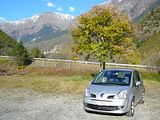
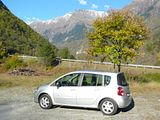
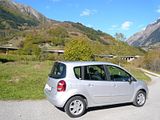
The Modus is a tall car, but the windows are deep, and there is a good glass area, so it feels quite light and airy inside. The dash in the test car was predominantly black, but with some silver insets in what is clearly plastic pretending to be aluminium. It does not better or worse a job of this pretence than in most other cars. There is a single binnacle in the centre of the dash, in which all the instruments and warning lights are displayed. A digital speedometer provides the centre, and in a semi-circular arc above this are the temperature gauge, rev counter and fuel level, each of which have approximately one sixth of a circumference of display area, and are presented as a set of bars. There are two blocks of warning lights, and there is a clock, along with an area where you can show either the odometer, or other trip computer functions, which are cycled through by pressing the button on the end of the wiper stalk. It is surprisingly easy to assimilate and looks quite neat. The central part of the dash contains some very Renault-like controls for the climate control, along with a small display area to show what is selected. Climate control would appear to be an option, though air conditioning is standard on the Dynamique model. Underneath this, and hence set quite low down, is a stereo system, which is easy to use, but has some rather small buttons to operate it. However, these are augmented by some also slightly fiddly controls mounted on the steering column. Stubby stalks on the column operate the lights, indicators and wipers, and the buttons for the cruise control are on the wheel itself. There is an automatic setting for both lights and wipers, which was useful.
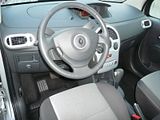
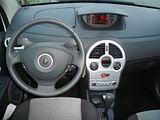
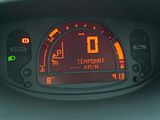 Sad to report that the build quality and fit of various items inside the Grand Modus was very poor. There is a compartment for the fuses mounted low on the dash above the driver’s knee. The cover was not fitted properly, and when I tried to rectify this, I could not. The glove box lid appeared pretty ill-fitting, standing somewhat proud of the surrounding dash area, and the lidded bin on top of the dash sat somewhat lower around some edges than the dash. There were a few nasty sharp edges to plastic mouldings where you could not see them, but could feel them, such as in the door pockets. While I was refuelling, I noticed the various shut lines around the tailgate were inconsistent, but with some huge panel gaps in places. So, although the dash moulding itself looked to be significantly better quality than we used to see in a Renault, and the key was a higher quality item that the Regie typically provided, it would seem that they still have not completely cracked the quality levels.
Sad to report that the build quality and fit of various items inside the Grand Modus was very poor. There is a compartment for the fuses mounted low on the dash above the driver’s knee. The cover was not fitted properly, and when I tried to rectify this, I could not. The glove box lid appeared pretty ill-fitting, standing somewhat proud of the surrounding dash area, and the lidded bin on top of the dash sat somewhat lower around some edges than the dash. There were a few nasty sharp edges to plastic mouldings where you could not see them, but could feel them, such as in the door pockets. While I was refuelling, I noticed the various shut lines around the tailgate were inconsistent, but with some huge panel gaps in places. So, although the dash moulding itself looked to be significantly better quality than we used to see in a Renault, and the key was a higher quality item that the Regie typically provided, it would seem that they still have not completely cracked the quality levels.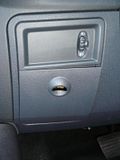
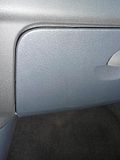
Practicality is the raison d’etre of a car like the Grand Modus. It starts in the front of the car, where pulling on a small tab in the front passenger seat allows the seat cushion to flip up and forwards to allow for mounting of a child seat. The rear seats are on sliders, so can be slid well forward, to increase luggage space, or right back to provide ample leg room for gangly teenagers or adults in the back seats. Whether the car is wide enough for three of them is perhaps a moot point, though. The boot is not overly generous, but this is a pretty small car, and it is deep. The luggage cover is split, with half of it mounted on the tailgate and half sits on top of the boot area, but it does not pivot. The forward facing part of this cover can be attached with some velcro to the rear seat backrest so that the whole of the boot contents could be covered even when the rear seats are well forward. The rear seats do fold, with an asymmetric split to the backrests, but the cushions did not appear to lift, leaving an uneven height to the newly extended boot area. There is no underfloor luggage area, as this space is allocated to the kit needed for the “get you home” foam kit unless you have paid the extra for a real spare wheel, but there are just two tiny little cavities on the sides of the boot. However, there is an underfloor cubby on the driver’s side floor, which would hold small items. There is also a lidded bin on top of the dash on the driver’s side where you would normally find the instruments, and there are reasonable door pockets on all four doors and a decent glovebox.
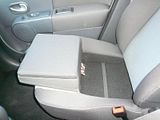
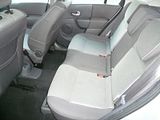
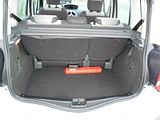
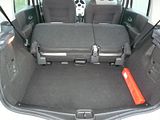
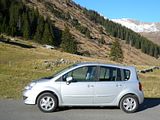
Objectively, my conclusion should be that I did not like the Grand Modus: the interior finish was poor, some of the controls were awkward, the brakes needed a light touch, it was noisy, not that economical and the engine/gearbox seemed ill-matched especially in the mountains. I will concede that this particular version of the range does not deserve a recommendation, but I suspect that with a manual gearbox and one of the other more modern engines, the Grand Modus could actually make a very practical small and roomy car. Let’s face it, you could have a Peugeot 1007, or a Ford Fusion, or a Vauxhall Meriva as an alternative? No?

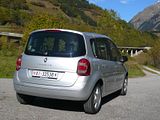
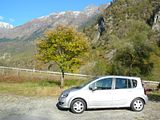

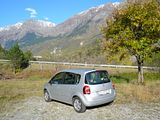

2009-10-27 08:06:40



















































